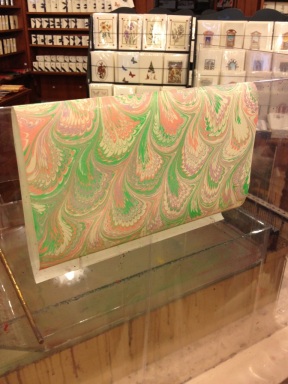Tags
Bernini, Florence, Gianlorenzo Bernini, Italy, Renaissance, Rome, Travel
How To Judge A Book By Its Cover
Did you ever wonder how that beautiful decorative Italian paper is created? No? Well, in all honesty, any curiosity I had didn’t keep me up at night either, but I am searching for new experiences and knowledge in Rome. So one day after Italian class recently I wandered into Il Papiro, a decorative paper and stationery store near Rome’s Pantheon that’s part of a chain originating in Florence. My friends and I were treated to an impromptu demonstration of how the gorgeous designs are made and preserved on paper.
First, a thick gel is used. It’s like wallpaper glue, explained the woman giving the demonstration:
Then, she tapped the chosen colors of paint from a brush onto the glue so that it looked somewhat like a Jackson Pollock design in the making.
Once the desired colors were resting on the glue’s surface, she took the end of a brush and ran it gently in a zig-zag fashion through the glue so that the colors were evenly spread in lines but not blended all together.
She wanted to show us different traditional patterns, so next she took a comb-like instrument and gently drew it across the paint.
Again taking the pointy-end of a brush, she made some more finishing touches to perfect the shell design:
Next, she carefully laid a piece of stiff parchment on top of the glue and then oh-so-delicately dragged it along on top and out of the glue…
And eccola—it’s miraculous!
From some quick research, I’ve since learned that paper-making began to flourish in Italy in the middle ages, and grew into an industry in Florence and the surrounding territories. According to A Brief History of Paper, by Neathery Batsell Fuller (yes, that really is the author’s name!), the rich and powerful Fabriano family held a monopoly on paper making, to the extent that fines of 50 ducats (about $225 in todays dollars) were levied against those who tried to open factories within 50 miles of Fabriano buildings.
The marbling design of decorative paper originated in the Middle East but made its way to Europe around the time of the Renaissance, where the Italians developed their own flourishes. Many of the same traditions are still followed today.
Italians (and Europeans in general) fell so in love with the colorful designs they not only began using them in book binding but in lining trunks and shelves, wallpaper and much more. I’m keeping my Italian diary in an Italian paper-bound notebook: No matter how illegible my handwriting or mundane my thoughts are on the inside—it’s elegant and intriguing if you judge it solely by its cover. Ciao!










